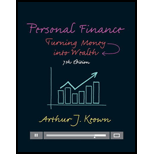
With a raise from his investment firm, Seyed Abdallah, 31, is inspired to look for a new home. Buying a home will allow Seyed, who is single and in the 25 percent marginal tax bracket, to itemize taxes. He has come to you for help.
Financially, he is fairly secure, but he is also very risk averse. His salary is $63,000 a year, but he does not know how much he should spend on housing. His current housing expenditures include rent of $900 per month and renter's insurance premiums totaling $150 per year. His monthly bills include a $450-per-month lease payment for his 2014 Acura TL and a $150-per-month student loan payment. He also paid a security deposit of 2 months’ rent from which he could be earning B percent after taxes.
Seyed has researched the recurring costs of home ownership. He has found that the real estate tax rate is $0.91 per $100 of assessed value and homeowners insurance policies cost approximately $275 per year. He is unsure of the maintenance costs but estimates them at $350 per year.
He likes the idea of owning his own home because as real estate values increase, the value of his home will increase instead of his rent payment. Local property values have been increasing at 5 percent per year over the last 7 years, and real estate sales commissions equal 6 percent of the purchase price. One of his concerns about buying a home is the immediate cost of the down payment and closing costs. These closing costs, he has found, include a 1 percent origination fee, two discount points on the mortgage, and 3 percent of the home purchase price in various other fees due at closing. He also knows that he will pay a 20 percent down payment up front to qualify for ?nancing. Another concern is the lost investment income on this money, which is currently earning an 8 percent alter-tax return.
5. Complete Worksheet lo to determine if Seyed should buy or continuerenting. To purchase the house considered in Question 4, Seyed wouldpay $6,000 in closing costs, including $2,500 in discount points. Consider1- and 7-year time horizons.
Want to see the full answer?
Check out a sample textbook solution
Chapter 8 Solutions
Personal Finance: Turning Money into Wealth (7th Edition) (Prentice Hall Series in Finance)
- Investors in corporate zero-coupon bonds include all of the following EXCEPT: A: Tax-exempt retirement plans B: Conservative investors who want to lock-in their returns C: Investors who are saving for their children's college education D: Investors who do not need current cash flows E: All of the above are potential zero-coupon investorsarrow_forwardWhat are some of Airbnb Legal Issues? How have Airbnb Resolved these Legal issues?WHat happened in the legal problem with Airbnb and Italy?arrow_forwardWhat are AIrbnb's Legal Foundations? What are Airbnb's Business Ethics? What are Airbnb's Corporate Social Responsibility?arrow_forward
- Discuss in detail the differences between the Primary Markets versus the Secondary Markets, The Money Market versus the Capital Market AND the Spot Market versus the Futures Market. Additionally, discuss the various Interest Rate Determinants listed in your textbook (such as default-risk premium.....).arrow_forwardHow can the book value still serve as a useful metric for investors despite the dominance of market value?arrow_forwardHow do you think companies can practically ensure that stakeholder interests are genuinely considered, while still prioritizing the financial goal of maximizing shareholder equity? Do you think there’s a way to measure and track this balance effectively?arrow_forward
- $5,000 received each year for five years on the first day of each year if your investments pay 6 percent compounded annually. $5,000 received each quarter for five years on the first day of each quarter if your investments pay 6 percent compounded quarterly. Can you show me either by hand or using a financial calculator please.arrow_forwardCan you solve these questions on a financial calculator: $5,000 received each year for five years on the last day of each year if your investments pay 6 percent compounded annually. $5,000 received each quarter for five years on the last day of each quarter if your investments pay 6 percent compounded quarterly.arrow_forwardNow suppose Elijah offers a discount on subsequent rooms for each house, such that he charges $40 for his frist room, $35 for his second, and $25 for each room thereafter. Assume 30% of his clients have only one room cleaned, 25% have two rooms cleaned, 30% have three rooms cleaned, and the remaining 15% have four rooms cleaned. How many houses will he have to clean before breaking even? If taxes are 25% of profits, how many rooms will he have to clean before making $15,000 profit? Answer the question by making a CVP worksheet similar to the depreciation sheets. Make sure it works well, uses cell references and functions/formulas when appropriate, and looks nice.arrow_forward
- 1. Answer the following and cite references. • what is the whole overview of Green Markets (Regional or Sectoral Stock Markets)? • what is the green energy equities, green bonds, and green financing and how is this related in Green Markets (Regional or Sectoral Stock Markets)? Give a detailed explanation of each of them.arrow_forwardCould you help explain “How an exploratory case study could be goodness of work that is pleasing to the Lord?”arrow_forwardWhat are the case study types and could you help explain and make an applicable example.What are the 4 primary case study designs/structures (formats)?arrow_forward
 Individual Income TaxesAccountingISBN:9780357109731Author:HoffmanPublisher:CENGAGE LEARNING - CONSIGNMENT
Individual Income TaxesAccountingISBN:9780357109731Author:HoffmanPublisher:CENGAGE LEARNING - CONSIGNMENT





